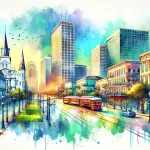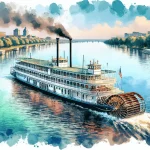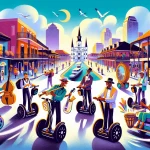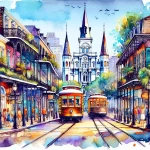New Orleans, a city deeply influenced by its cultural melting pot and storied past, has long captivated filmmakers from around the globe. From its iconic architecture and lively music scene to its unique blend of traditions, the Crescent City has provided a spellbinding backdrop for countless cinematic masterpieces.
In This Article
TL;DR
- Films have beautifully captured New Orleans’ distinct cultural identity, shaped by diverse influences, offering audiences a glimpse into its essence.
- These cinematic works contribute to a deeper understanding and appreciation of the city’s unique character, traditions, and way of life.
- They have had a profound impact on both local and global audiences, fostering cultural exchange and shaping perceptions of New Orleans.
Introduction to New Orleans Films
New Orleans’ allure has drawn filmmakers from far and wide, enchanted by its captivating blend of French, Spanish, African, and American influences. The city’s unique identity, woven from various cultures, has been skillfully captured in the fabric of countless films, preserving the essence of its vibrant spirit.
From the iconic French Quarter to the lively jazz clubs and the mouth-watering Creole cuisine, New Orleans has provided a stunning backdrop for stories that resonate with audiences worldwide. These films not only entertain but also serve as a window into the city’s soul, offering a glimpse into its rich history, traditions, and way of life.
Historical Context of New Orleans in Cinema
The city’s cinematic journey began in the early 20th century, with films like “Panic in the Streets” (1950) and “A Streetcar Named Desire” (1951) setting the stage for future cinematic endeavors. These early works captured the essence of New Orleans’ past, showcasing its architectural marvels, bustling port, and the gritty realities of life in the city.
As the decades passed, filmmakers continued to be drawn to the city’s unique charm, with each new production adding another layer to the rich tapestry of New Orleans’ cinematic legacy. From the haunting gothic tales of “Interview with the Vampire” (1994) to the whimsical adventures of “The Princess and the Frog” (2009), these films have preserved the city’s transformation over time, offering a glimpse into its ever-evolving identity.
Iconic New Orleans Films
The Big Easy
Among the many films that have graced the silver screen, a few stand out as quintessential representations of New Orleans’ spirit. “The Big Easy” (1987), starring Dennis Quaid and Ellen Barkin, is a captivating crime drama that immerses viewers in the city’s sultry atmosphere and vibrant nightlife. The film’s gritty realism and authentic portrayal of the local culture have made it a beloved classic.
The Curious Case of Benjamin Button
Another iconic film, “The Curious Case of Benjamin Button” (2008), directed by David Fincher, takes viewers on a magical journey through the city’s past. With its stunning visuals and poignant storytelling, the film captures the essence of New Orleans’ timeless charm, weaving a tale of love, loss, and the enduring human spirit.
The Music and Festivities of New Orleans in Film
No exploration of New Orleans’ cinematic legacy would be complete without acknowledging the city’s rich musical heritage and its legendary festivals. Films like “The Buccaneer” (1958) and “Live and Let Die” (1973) have showcased the infectious energy of Mardi Gras, capturing the vibrant colors, elaborate costumes, and infectious rhythms that define this iconic celebration.
Meanwhile, films such as “The Blues Brothers” (1980) and “Treme” (2010-2013) have paid homage to the city’s jazz roots, immersing audiences in the soulful melodies and improvisational brilliance that have made New Orleans a mecca for music lovers worldwide.
The Creole and Cajun Influence
Integral to New Orleans’ identity are the Creole and Cajun cultures, which have left an indelible mark on the city’s culinary traditions, language, and way of life. Films like “Eve’s Bayou” (1997) and “Beasts of the Southern Wild” (2012) have offered a poignant and authentic portrayal of these communities, their struggles, resilience, and rich cultural heritage.
Through these films, audiences have been introduced to the unique dialects, mouth-watering cuisine, and vibrant traditions that have shaped the Creole and Cajun experience. From the bayous and swamps to the bustling city streets, these films have captured the essence of a way of life that is deeply rooted in the fabric of New Orleans.
Modern New Orleans Films and Their Cultural Relevance
As the city continues to evolve, so too do the narratives and themes explored in contemporary New Orleans films. Recent productions like “Mudbound” (2017) and “Green Book” (2018) have tackled complex issues of race, class, and social justice, reflecting the city’s ongoing struggle with inequality and its efforts to confront its past.
Other films, such as “Benh Zeitlin’s “Wendy” (2020), have embraced the city’s unique blend of fantasy and reality, offering a whimsical yet poignant exploration of themes like childhood, imagination, and the power of storytelling.
Key Figures in New Orleans Cinema
New Orleans’ cinematic legacy has been shaped by a host of talented directors, actors, and filmmakers who have called the city home. From the legendary Elia Kazan, whose “Panic in the Streets” (1950) captured the gritty realism of post-war New Orleans, to contemporary visionaries like Benh Zeitlin and Kasi Lemmons, these artists have played a pivotal role in bringing the city’s culture to the silver screen.
Actors like Wendell Pierce, known for his roles in “Treme” and “The Twilight Zone,” have become ambassadors for New Orleans, using their platform to celebrate the city’s rich heritage and advocate for its preservation.
Film Festivals and Cinematic Events in New Orleans
New Orleans’ vibrant film community is celebrated through a variety of festivals and events that attract both local and global audiences. The New Orleans Film Festival, held annually, showcases a variety of independent and international films, fostering a dialogue between filmmakers and cinephiles from around the world.
Other events, such as the French Film Festival and the New Orleans Video Access Center’s (NOVAC) screenings, provide platforms for emerging talent and celebrate the city’s deep-rooted connections to French and Francophone cultures.
Economic Impact of Filmmaking in New Orleans
Beyond its cultural significance, the film industry has also played a crucial role in the city’s economic development. With its unique locations, skilled workforce, and tax incentives for filmmakers, New Orleans has become a hub for film and television production, attracting major studios and independent filmmakers alike.
This influx of production activity has created numerous job opportunities for locals, from crew members and actors to support staff and vendors. Additionally, the presence of film crews and tourists drawn to the city’s cinematic allure has provided a significant boost to the local hospitality and tourism industries.
Cultural Impact and Global Influence
New Orleans’ films have not only captured the hearts of local audiences but have also resonated with viewers worldwide. These cinematic works have played a pivotal role in shaping global perceptions of the city, showcasing its rich cultural tapestry and fostering a deeper appreciation for its unique traditions.
Through their international reach and critical acclaim, films like “Beasts of the Southern Wild” and “Mudbound” have sparked conversations about issues of social justice, environmental conservation, and the resilience of marginalized communities, contributing to a broader cultural exchange and understanding.
As the city continues to evolve and new stories emerge, the world eagerly awaits the next chapter in New Orleans’ cinematic legacy, a testament to the enduring allure of this vibrant and captivating city.






